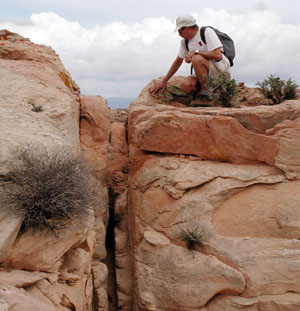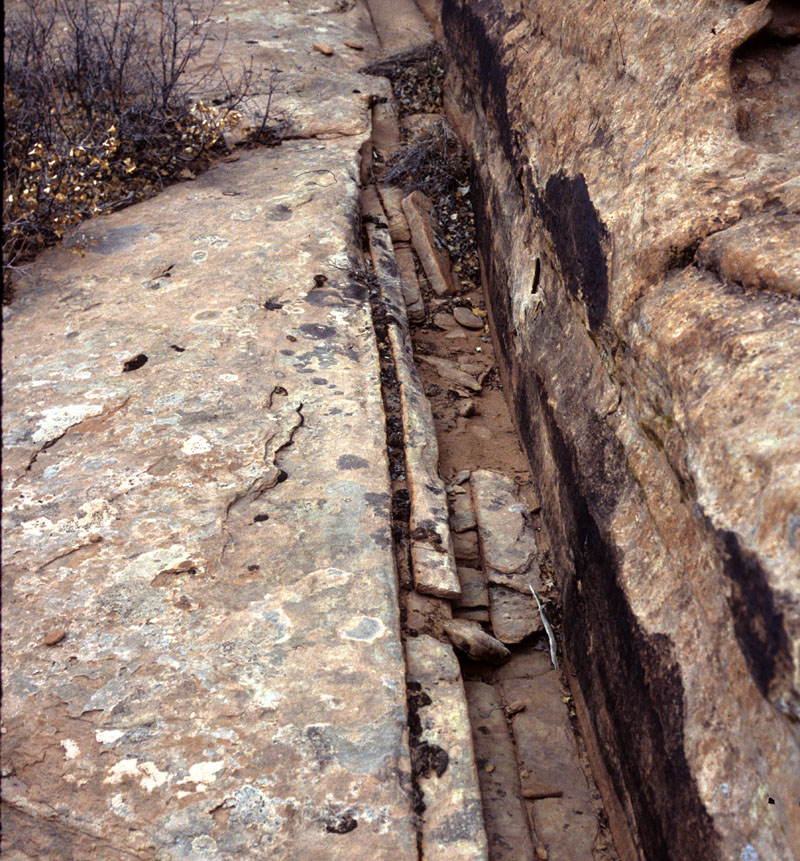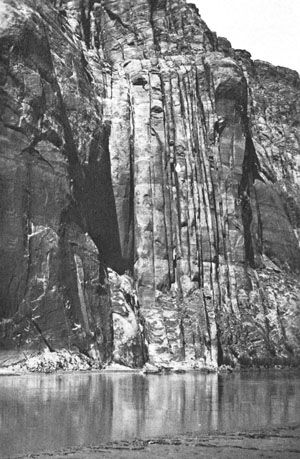|
A series of field photographs illustrating joint zones also known as joint clusters, corridors, and swarms. These descriptive terms refer to a structure in which component joints are localized into a narrow zone, with joint spacing being much smaller than that of the systematic spacing outside the zone. The width of joint zones in the field varies from centimeters (Figure 1 and Figure 2) to tens of meters (Figure 3 and Figure 4). Neighboring joints may be arranged echelon with commonly large overlaps. See the detailed characterizations of zones by Auzias (1995), Dyer (1983), Cruikshank and Aydin (1994), Laubach (1991), Aydin (2000), Olson (2004), and Florez-Nino et al. (2005).
 | | Figure 1. Photo showing a cross-section view of a joint zone of about 0.8 m wide in the Entrada Sandstone, Arches National Park, Utah. Note that there are at least five joints of similar orientation within the zone and no joints of the same orientation (up and down) within the surrounding rocks immediately adjacent to the zone. |
 | | Figure 2. Photo showing map view of the same joint zone as in the previous figure (Figure 1). Note that individual joints within the zone (about eight of them at this locality) are subparallel and those on the left-hand side terminate systematically so that adjacent joints are echelon but with large overlaps. |
 | | Figure 3. A relatively wider joint zone in the clastic rocks exposed on a steep river bank. The width of the frame is about 25 m. Taughannock Falls, Finger Lakes, NY. |
 | | Figure 4. A wide fracture zone at the center of the photograph containing mostly vertical joints and perhaps some sheared joints (judging from the presence of some fractures at an angle to the vertical ones) on the Colorado River bank at Lees Ferry, Grand Canyon, AZ. From Billings (1972) with credit for E. C. LaRue. |
Joint zones are weaker than the surroundings and thus prone to shearing more than the surrounding rocks. A small magnitude of shear acting across a pre-existing joint zone may produce splays thereby bridging across the adjacent, previously separate or isolated joints. This divides the slabs between the sheared joints into smaller pieces and increases the aperture of the fracture system and the connectivity among neighboring sheared joints. These issues are discussed further under 'Splay Joints,' 'Faulting by Shearing of Joints,' and 'Fault Damage Zones.' Some of these are also discussed in 'Mechanisms and Mechanics of Joint Zones.'
| |
Auzias, V., 1995. Fracture characterization in the Devonian Old Red Sandstone, Caithness and Orkney. Elf Aquitaine report (unpublished).
Aydin, A., 2000. Fractures, faults, and hydrocarbon entrapment, migration and flow. Marine and Petroleum Geology 17 (7): 797 - 814.
Cruikshank, K.M., Aydin, A., 1994. Role of fracture localization in arch formation, Arches National Park, Utah. Geological society of America Bulletin 106: 879-891.
Dyer, J.R., 1983. Jointing in sandstones, Arches National Park, Utah. Ph. D. Dissertation, Stanford University, 202 p.
Florez-Nino, J.M., Aydin, A., Mavko, G., Antonellini, M., Ayaviri, A., 2005. Fault and fracture systems in a fold and thrust belt: An example from Bolivia. American Association of Petroleum Geologists Bulletin 89: 471-493.
Laubach, S.E., 1991. Fracture Patterns in Low-Permeability-Sandstone Gas Reservoir Rocks in the Rocky Mountain Region. SPE Special paper 21853.
Olson, J., 2004. Predicting fracture swarms - the influence of subcritical crack growth and the crack-tip process zone on joint spacing in rock. The Initiation, Propagation, and Arrest of Joints and Other Fractures. Geological Society, London, Special Publications 231: 73-87.
|



